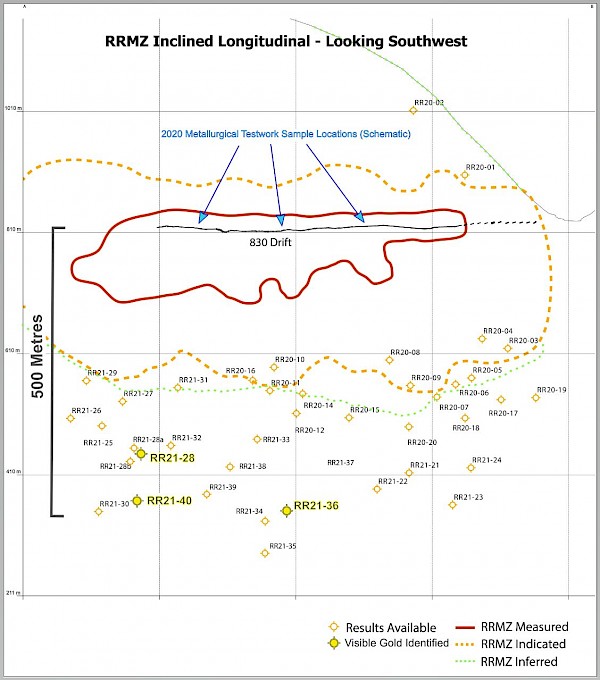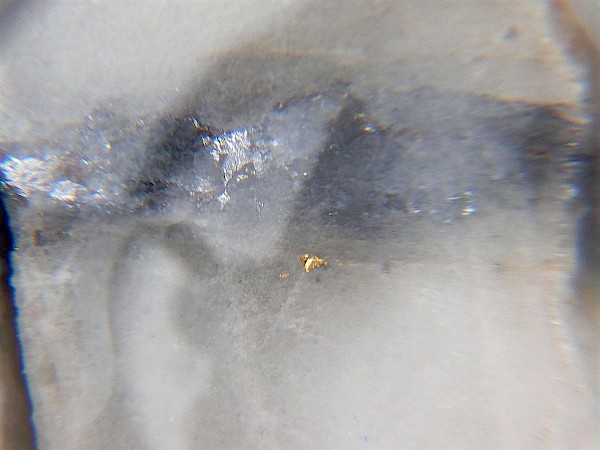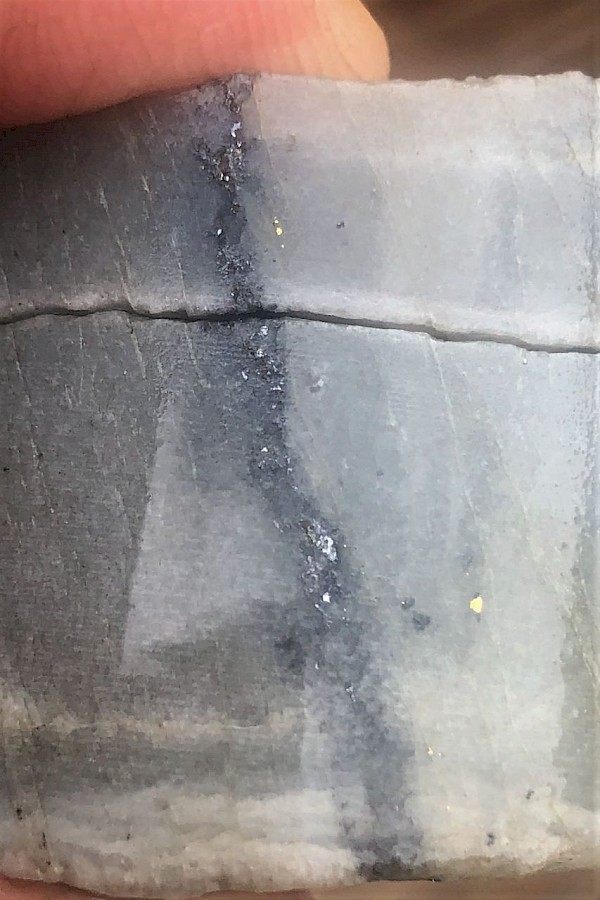News Releases
Coarse, Visible, Particulate Gold Grains Discovered in Deeper Underground Drillholes at the Revel Ridge Project
(Vancouver, June 7, 2021 – Rokmaster Resources Corp. (TSXRV: RKR) (OTCQB: RKMSF) (FSE: 1RR1) (“Rokmaster” or the “Company”) reports definitive and highly positive assay results from metallic screened samples containing discrete, macroscale gold grains with no significant sulphide association. The assay results (Table 1) of the metallic screened samples conclusively demonstrate:
- The identification of visible, particulate gold grains in drillholes where significant gold assays are reported and further associated with substantially reduced arsenic concentrations. Drillhole intersections with these characteristics currently include underground diamond drillholes RR21-28, RR21-36, and RR21-40.
- Metallic screening indicates that “free gold” in these samples may occur in grains which are greater than 106 microns in size, which for the purposes of metallurgy would be classified as coarse particulate grains.
- Three drillholes containing macroscale gold grains are separated along strike by 330 m, all at relatively deep depths within the laterally and vertically persistent Revel Ridge Main Zone (RRMZ).
- Particulate gold was intersected approximately 380 to 490 m vertically below the 830 m drift. The spatial relationships between these drillholes are illustrated on Figure 1.
- Of the six samples submitted for metallic screen assay analysis, three samples had significantly higher gold contents than the initial analysis, one sample was approximately equivalent, and two samples had reduced gold assay values. Increased analytical variability may be one of the hallmark characteristics of particulate gold assays, per Table 1.
- In all three drillholes, particulate gold is associated with quartz and or quartz+/-carbonate foliation parallel veins sometimes containing other base metal phases and occasionally arsenopyrite. Qualitative, textural and mineralogical characteristics suggests that veins containing coarse gold grains may post-date the formation of auriferous-arsenical high sulphide orogenic veins. Gold in this resident site is not locked into a sulphide phase and has a high probability of being recovered by standard, lower cost metallurgical processes, including gravity.
Table 1. Screened Metallic Fire Assay Results versus Fire Assay Results. Selected Drilholes, RRMZ.
|
DDH |
From (m) |
To |
Length (m) |
Au g/t* |
Au g/t |
Au g/t |
Au g/t |
|
|---|---|---|---|---|---|---|---|---|
|
RR21-28 |
450.00 |
451.30 |
1.30 |
15.01 |
16.80 |
207.30 |
11.63 |
|
|
|
|
|
|
|
|
|
|
|
|
RR21-36 |
535.85 |
536.75 |
0.90 |
22.22 |
18.40 |
181.80 |
14.46 |
|
|
RR21-36 |
536.75 |
538.04 |
1.29 |
12.98 |
13.60 |
303.00 |
5.79 |
|
|
|
|
|
|
|
|
|
|
|
|
RR21-40 |
517.50 |
518.50 |
1.00 |
7.14 |
1.10 |
44.50 |
0.47 |
|
|
RR21-40 |
518.50 |
519.50 |
1.00 |
0.10 |
<0.90 |
<0.90 |
0.11 |
|
|
RR21-40 |
519.50 |
520.50 |
1.00 |
27.19 |
51.00 |
985.70 |
21.80 |
|
|
|
|
|
|
|
|
|
|
|
*1. Au g/t (30 g FA – AAS) is the original fire assay of the original drill hole sample collected prior to metallic screening.
*2. Au g/t (1.0 kg Metallic Screen) is a 1.0 kg sample which contains the calculated weighted average gold content of both the oversize (+) and undersize (-) samples or the total metallically screened gold in the sample.
*3. Au g/t (+106 um Fraction) is the result of a fire assay gravimetric finish (FAS – 415) of all grains greater than or equal to 106 microns.
*4. Au g/t (-106 um Fraction) is all gold grains in the sample which is less than or equal to 106 microns and is analyzed by instrument finish (FAS-211).
Reported widths of mineralization are drill hole intervals or core length recovered. Insufficient data exists to permit the calculation of true widths of the reported mineralized intervals.
John Mirko, President and CEO of Rokmaster commented, “For decades, the Revel Ridge Main Zone mineralization has been perceived as an exceptionally significant gold deposit, albeit one with problematic metallurgical characteristics. Two events have unfolded in the past year which challenge this perception. The metallurgical studies undertaken by Rokmaster have definitively demonstrated that approximately 15% of gold mineralization within the deposit is present as free milling “ore” and could be recovered by using advanced grinding and liberation methods. The remainder of gold is intimately associated with sulphide phases and is recovered by processing methods including Pressure Oxidation (POX). Very significantly, the 2020 metallurgical results were all obtained from bulk samples collected from the 830 m drift. Most recently, particulate gold identified in DDH’s RR21-28, RR21-36, and RR21-40 convincingly demonstrate that Main Zone mineralization, at deeper depths in the RRMZ system, has the ability to produce relatively coarse macroscale gold. At deeper portions of the RRMZ, the gold “budget” may be shifting from gold associated with sulphide phases to free milling particulate gold. Rokmaster’s technical team is further reviewing 2020 and 2021 drillholes for similar particulate gold geochemical signatures. These data begin to challenge historical perceptions regarding gold metallurgical characteristics at Revel Ridge. The presence of coarse particulate gold within the RRMZ could significantly enhance the mineral economics of this already superb deposit.”
The inclined long section showing 2020-2021 drill hole locations presented as Figure 1 is named “Main Zone Inclined Longitudinal Section” and is available on rokmaster.com/projects/revel-ridge/maps-and-figures.
Quality Assurance/Quality Control. Dr. Jim Oliver, P. Geo., supervised all aspects of the drilling and sampling undertaken in the 2020 underground diamond drill program. All samples have been collected from ½ NQ™ core, sawn with a diamond saw with the sample intervals marked by technical personnel. A full QAQC program using blanks, standards and duplicates was utilized to monitor analytical accuracy and precision. The samples were sealed on site and shipped to MSA Labs in Langley, British Columbia. MSA is an ISO 17025 (Testing and Calibration Laboratory) and an ISO 9001 (Quality Management System) Certified Laboratory. Standard core processing includes crushing the sample to 2 mm and a 250 g sub sample was pulverized with 85% of the sample passing 75 microns. The sub sample was analysed using a combination of MSA Labs FAS211 for Au and ICP–240 (4 acid digestion) for silver, base metals and other trace elements. FAS211 for gold is an ore grade fire assay of a 30 g pulp with an AAS finish with a detection range between 0.01 and 100 ppm). ICP-240 utilizes four acid digestion and provides ore grade analytical data on silver, base metals and 26 other elements.
Metallically screened samples are processed by crushing 1.0 kg of rock to 106 um. The entire plus (+) size fraction is analyzed while the minus (-) fraction is analyzed in duplicate. Both fractions use fire assay techniques with a gravimetric or instrumental finish. The two fractions are then combined using a weighted average of the volume of rock contained within the plus (+) and minus (-) samples and their relative gold contents which produces the calculated total gold content of the combined oversized and undersized metallically screened samples.
The technical information in this news release has been prepared in accordance with Canadian regulatory requirements as set out in National Instrument 43-101 and reviewed and approved by Mark Rebagliati, P. Eng., FEC, who is independent of Rokmaster.
For more information please contact Mr. John Mirko, CEO of Rokmaster Resources, jmirko@rokmaster.com, Ph. 1-604-290-4647 or the Company’s website: www.rokmaster.com
On Behalf of the Board of Directors of
Rokmaster Resources Corp.
John Mirko,
President & Chief Executive Officer
Neither TSX Venture Exchange nor its Regulation Services Provider (as that term in defined in the policies of the TSX Venture Exchange) accepts responsibility for the adequacy or accuracy of this press release.
CAUTIONARY NOTE REGARDING FORWARD LOOKING STATEMENTS: This news release may contain forward-looking information within the meaning of applicable securities laws (“forward-looking statements”). Forward-looking statements are statements that are not historical facts and are generally, but not always, identified by the words “expects,” “plans,” “anticipates,” “believes,” “intends,” “estimates,” ‘projects,” “potential” and similar expressions, or that events or conditions “will,” “would,” “may,” “could” or “should” occur. These forward-looking statements are subject to a variety of risks and uncertainties which could cause actual events or results to differ materially from those reflected in the forward-looking statements, including, without limitation: risks related to fluctuations in metal prices; uncertainties related to raising sufficient financing to fund the planned work in a timely manner and on acceptable terms; changes in planned work resulting from weather, logistical, technical or other factors; the possibility that results of work will not fulfill expectations and realize the perceived potential of the Company’s properties; risk of accidents, equipment breakdowns and labour disputes or other unanticipated difficulties or interruptions; the possibility of cost overruns or unanticipated expenses in the work program; the risk of environmental contamination or damage resulting from Rokmaster’s operations and other risks and uncertainties. Any forward-looking statement speaks only as of the date it is made and, except as may be required by applicable securities laws, the Company disclaims any intent or obligation to update any forward-looking statement, whether as a result of new information, future events or results or otherwise.




